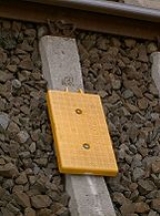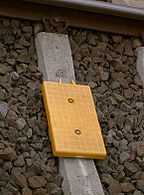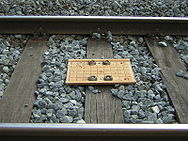
Balise
Encyclopedia

Transponder
In telecommunication, the term transponder has the following meanings:...
placed between the rail
Rail tracks
The track on a railway or railroad, also known as the permanent way, is the structure consisting of the rails, fasteners, sleepers and ballast , plus the underlying subgrade...
s of a railway as part of an Automatic Train Protection
Automatic Train Protection
Automatic Train Protection in Great Britain refers to either of two implementations of a train protection system installed in some trains in order to help prevent collisions through a driver's failure to observe a signal or speed restriction...
(ATP) system. The French
French language
French is a Romance language spoken as a first language in France, the Romandy region in Switzerland, Wallonia and Brussels in Belgium, Monaco, the regions of Quebec and Acadia in Canada, and by various communities elsewhere. Second-language speakers of French are distributed throughout many parts...
word "balise" is used to distinguish these beacons from other kinds of beacon.
Balises are used in the KVB signalling system installed on main lines of the French railway network, other than the high-speed Lignes a Grande Vitesse
TGV
The TGV is France's high-speed rail service, currently operated by SNCF Voyages, the long-distance rail branch of SNCF, the French national rail operator....
.
Balises constitute an integral part of the European Train Control System
European Train Control System
The European Train Control System is a signalling, control andtrain protection system designed to replace the many incompatible safety systems currently used by European railways, especially on high-speed lines.- History :...
, where they serve as 'beacons' giving the exact location of a train. The ETCS signalling system is being gradually introduced on railways throughout the European Union
European Union
The European Union is an economic and political union of 27 independent member states which are located primarily in Europe. The EU traces its origins from the European Coal and Steel Community and the European Economic Community , formed by six countries in 1958...
.
Balises are also used in the Chinese Train Control System
Chinese Train Control System
The Chinese Train Control System is a train control system used on railway lines in People's Republic of China. CTCS is similar to the European Train Control System ....
versions CTCS-2 and CTCS-3 installed on high-speed rail lines in China, which is based on the European Train Control System
European Train Control System
The European Train Control System is a signalling, control andtrain protection system designed to replace the many incompatible safety systems currently used by European railways, especially on high-speed lines.- History :...
.
A balise which complies with the European Train Control System specification is called a Eurobalise.
Overview

Radio frequency
Radio frequency is a rate of oscillation in the range of about 3 kHz to 300 GHz, which corresponds to the frequency of radio waves, and the alternating currents which carry radio signals...
energy broadcast by a Balise Transmission Module mounted under a passing train, the balise either transmits information to the train ('Uplink') or receives information from the train ('Downlink,' this function is rarely used). The transmission rate is sufficient for a complete 'telegram' to be received by a train passing at any speed up to 500 km/h.
A balise may be either a 'Fixed Data Balise,' or 'Fixed Balise' for short, transmitting the same data to every train, or a 'Transparent Data Balise' which transmits variable data, also called a 'switchable' or 'Controllable Balise'. (Note that the word 'fixed' refers to the information transmitted by the balise, not to its physical location. All balises are immobile).
A fixed balise is programmed to transmit the same data to every train. Information transmitted by a fixed balise typically includes: the location of the balise; the geometry of the line, such as curves and gradients; and any speed restrictions. The programming is performed using a wireless programming device. Thus a fixed balise can notify a train of its exact location, and the distance to the next signal, and can warn of any speed restrictions.
A controllable balise is connected to a Lineside Electronics Unit (LEU), which transmits dynamic data to the train, such as signal indications. Balises forming part of a ETCS Level 1 signalling system employ this capability. The LEU integrates with the conventional (national) signal system either by connecting to the lineside railway signal
Railway signal
A signal is a mechanical or electrical device erected beside a railway line to pass information relating to the state of the line ahead to train/engine drivers. The driver interprets the signal's indication and acts accordingly...
or to the signalling control
Signalling control
On a rail transport system, signalling control is the process by which control is exercised over train movements by way of railway signals and block systems to ensure that trains operate safely, over the correct route and to the proper timetable...
tower.
Balises are deployed in pairs so that the train can determine its direction of travel 1->2 from direction 2->1. Extra balises can be installed if the volume of data is too great.
Balises operate with equipment on the train to provide a system that enhances the safety of train operation.
Installation
The balise is typically mounted on or between sleepersRailroad tie
A railroad tie/railway tie , or railway sleeper is a rectangular item used to support the rails in railroad tracks...
in the centre line of the track. The pair of beacons are typically 3 metres apart.
A train travelling in the normal direction will meet the fixed balise and then the switchable balise.
A train travelling at maximum speed of 500 km/h will transmit and receive a minimum of three copies of the telegram while passing over the balise. If more information needs to be transmitted, then a third or fourth balise can be installed.
The train's on-board computer uses the data from the balises to determine the safe speed profile for the line ahead. Enough information is needed to allow the train to come to a safe standstill if required.
The data in the balise also includes the distance to the next balise. This is used to check for missing balises which would otherwise be a potential wrong-side failure
Wrong-side failure
A wrong side failure describes a failure condition in a piece of railway signalling equipment that results in an unsafe state.A typical example would be a signal showing a 'proceed' aspect when it should be showing a 'stop' or 'danger' aspect, resulting in a "false clear"...
.
Balises have been used in Germany to transmit tilting instructions for curves to tilting train
Tilting train
A tilting train is a train that has a mechanism enabling increased speed on regular rail tracks. As a train rounds a curve at speed, objects inside the train experience centrifugal force. This can cause packages to slide about or seated passengers to feel squashed by the outboard armrest due to...
s.
At the start and end of ATP equipped territory, a pair of fixed balises turn on and turn off the ATP equipment.
Encoding
Each pair of balises consist of a switchable balise and a fixed balise. A balise transmits a 'telegram' of either 1023 bits (93*11) or 341 bits (31*11) in the channel encoding with 11 bit per symbol. The user data block is cut into 10-bit user symbols before the scrambling and shaping operation - the effective payload of signalling information is 830 bit (83*10) for the long telegram and 210 bit (21*10) for the short telegram. The final telegram consists of- shaped data (913 bit or 231 bit) containing the payload (830 or 210 bit)
- control bits (Cb, 3 bit)
- scrambling bits (Sb, 12 bit)
- extra shaping bits (Esb, 10 bit)
- checksum (CheckBits, 85 bit)
The telegram is broadcast in a cyclic manner as the train passes over the balise. To avoid transmission errors the payload is scrambled (avoiding burst errors), substituted with a symbol code of different Hamming distance
Hamming distance
In information theory, the Hamming distance between two strings of equal length is the number of positions at which the corresponding symbols are different...
, and a checksum is added for validity checks. Since the checksum is computed after the symbol substitution the telegram contains extra shaping bits to allow the resulting checksum bits to be filled up in a way that only valid symbols of the chosen channel code
Channel code
In digital communications, a channel code is a broadly used term mostly referring to the forward error correction code and bit interleaving in communication and storage where the communication media or storage media is viewed as a channel...
are in the telegram where each symbol has 11 bits.
The payload data consists of a header followed by multiple packets defined in the ERTMS
European Rail Traffic Management System
The European Rail Traffic Management System is an initiative backed by the European Union to enhance cross-border interoperability and signalling procurement by creating a single Europe-wide standard for train control and command systems....
protocols. Mandatory packets are Packet5 - Linking information, Packet 12 - Movement Authority, Packet 21-Gradient, Packet 27 - Static Speed Profile, Packet 255 - End of information. Many applications include optional packets like Packet 3 - National Values, Packet 41 - Level transition and Packet 136 - Infill Location Reference. If the telegram maximum of 830 bits is reached then more packets can be sent in the following balises of the same balise group - with up to 8 balises in a balise group the maximum ERTMS message per balise group can encompass 8 * 830 = 6640 bit (note that every telegram must contain a header and the trailer packet 255). A fixed balise transmits a stable message with the movement authorization, including link message, gradient information, speed limitation. Especially in China, it may contain track information.
Almost all packet types contain a parameter flagging whether its information is relevant for the "nominal" or "reverse" direction (or both). If a train will see balise 1 before balise 2 then it runs in nominal direction. Consequently some packets may be dropped by the application software of the receiver. The ERTMS Header block of 50 bit contains the ETCS version, the current number and total count of balises within a balise group (up to 8 balises), a flag whether it is a copy (up to 4 copies) that increases chances for the receiver to see the telegram of the balise in a group, a serial number flagging whether the message has changed lately, a 10-bit country identifier along with the 14-bit balise group identifier allowing for a unique ID of every balise group. The required link information informs about the distance to the next balise group (one link packet per direction) and the required train reaction if the next balise is missed (e.g. train stop). The movement authority packet defines a maximum speed that may be used for a given maximum distance and maximum time - setting the maximum speed to zero on a variable balise will make the train to stop. The gradient profile may have a variable length based on the contained pairs of section length (scalar and number in the metric system) and section gradient (uphill/downhill flag and a number in ‰). Similarly the static speed profile is given in a variable count of section parts with each part denoting the section length (number in meters - a possible scale is only given once at the start of the packet for all sections), the maximum speed (number * 5 km/h - allowed numbers are 0-120 i.e. some spare values are left) and a flag if the speed restriction applies to the front or rear end of the train (possibly allowing for a delay). The trailer packet does only contain its packet id with no parameters where 255 equals the state of all bits set in the 8-bit packet id field (11111111).
Manufacture
Balises are made by several different companies; while they may vary in the details, they are manufactured to meet the same standards. The principal manufacturers of Eurobalises belong to a group of seven firms (AlstomAlstom
Alstom is a large multinational conglomerate which holds interests in the power generation and transport markets. According to the company website, in the years 2010-2011 Alstom had annual sales of over €20.9 billion, and employed more than 85,000 people in 70 countries. Alstom's headquarters are...
, Ansaldo STS
Ansaldo STS
Ansaldo STS S.p.A. is a multinational technology company which produces signalling and automation systems for use by rail and rapid transit operators. The firm also acts as lead contractor and turnkey provider on new rail developments...
, Bombardier
Bombardier Transportation
Bombardier Transportation is the rail equipment division of the Canadian firm, Bombardier Inc. Bombardier Transportation is one of the world's largest companies in the rail-equipment manufacturing and servicing industry. Its headquarters are in Berlin, Germany....
, Invensys, Siemens
Siemens
Siemens may refer toSiemens, a German family name carried by generations of telecommunications industrialists, including:* Werner von Siemens , inventor, founder of Siemens AG...
, Sigma-Digitek, Thales
Thales Group
The Thales Group is a French electronics company delivering information systems and services for the aerospace, defense, transportation and security markets...
) within the UNIFE
UNIFE
UNIFE – the Association of the European Rail Industry – represents Europe’s leading rail supply companies active in the design, manufacturing, maintenance and refurbishment of rail transport systems, subsystems and related equipment...
federation of railway suppliers. This group cooperated in developing the specifications for Eurobalises. Specifications for Eurobalises are governed by the European Railway Agency
European Railway Agency
The European Railway Agency is one of the agencies of the European Union. The decision to set up the agency was made in April 2004. The agency has two main sites, both in Nord Department, France...
.
Usage
Eurobalises are used in- ETCSEuropean Train Control SystemThe European Train Control System is a signalling, control andtrain protection system designed to replace the many incompatible safety systems currently used by European railways, especially on high-speed lines.- History :...
– the European-wide train protection system - Chinese Train Control SystemChinese Train Control SystemThe Chinese Train Control System is a train control system used on railway lines in People's Republic of China. CTCS is similar to the European Train Control System ....
versions CTCS-2 and CTCS-3, used on high speed rail lines in China - EuroSignum – a variant of the earlier Swiss Integra-SignumIntegra-SignumIntegra-Signum is a Swiss train protection system introduced in 1933. Originally it was called Signum; the name Integra was added later. It transmits data inductively and is simple, robust and reliable also in snow.-How it works:...
train protection system - EuroZub – a variant of the earlier Swiss ZUB 121 train protection system
- SCMT – an Italian train protection system
- TBLTBLTBL may refer to:* Tampa Bay Lightning, a professional ice hockey team of the NHL* Tanzania Breweries Limited, a Tanzanian brewery firm owned by South African Breweries* Toronto Blue Jays, a professional baseball team of the MLB's American League...
1+ – a train protection system used in Belgium - GNT – the system to control tilting trains in Germany
- ZBSZugbeeinflussungssystem S-Bahn BerlinThe Berlin S-Bahn Train Control System - Zugbeeinflussungssystem S-Bahn Berlin - is a train protection system based on Eurobalises that is designed for the specific requirements of the S-Bahn Berlin rapid transit rail network...
– a new rapid transit control system for the S-Bahn Berlin
See also
- Automatic Warning SystemAutomatic Warning SystemThe Automatic Warning System is a form of limited cab signalling and train protection system introduced in 1956 in the United Kingdom to help train drivers observe and obey signals. It was based on a 1930 system developed by Alfred Ernest Hudd and marketed as the "Strowger-Hudd" system...
- Cab signallingCab signallingCab signalling is a railway safety system that communicates track status information to the cab, crew compartment or driver's compartment of a locomotive, railcar or multiple unit, where the train driver or engine driver can see the information....
- EBICABEBICABEBICAB is a trade mark registered by Bombardier for the equipment on board a train used as a part of a Automatic Train Control system. EBICAB was originally derived from Ericsson's SLR system in Sweden. Most trains in Sweden an Norway uses a similar on-board system, Ansaldo L10000 from...
- LinienzugbeeinflussungLinienzugbeeinflussungLinienzugbeeinflussung is a cab signalling andtrain protection system used on selected German and Austrian railway linesas well as the AVE in Spain.In Germany, the system is mandatory on all lines where trains exceed speeds of...
- Positive Train ControlPositive Train ControlPositive train control is a system of monitoring and controlling train movements to provide increased safety.-Overview:The main concept in PTC is that the train receives information about its location and where it is allowed to safely travel, also known as movement authorities...
- Train Protection & Warning System
External links
- SUBSET-036 Specification for Eurobalises (PDF; 1,12 MB)
- Eurobalise S21 by Siemens Transportation Systems (PDF; 1,33 MB)
- Eurobalise by Alstom
- Beijing Railway Signal Factory

